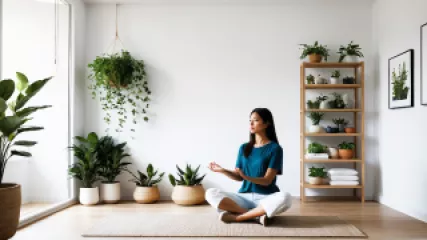A Mindful Guide to Decluttering: Taming Emotional Effects of Clutter
A Mindful Guide to Decluttering: Taming Emotional Effects of Clutter
Clutter can have a profound impact on our mental and emotional well-being, often without us even realizing it. In this step-by-step tutorial, we'll explore the emotional effects of clutter and provide you with a mindful approach to decluttering your space and your mind.
Understanding the Emotional Toll of Clutter
Clutter is more than just physical items piling up in our living or working spaces. It can also have a significant impact on our psychological and emotional state. When we're surrounded by an overwhelming amount of stuff, it can trigger feelings of anxiety, stress, and a sense of being overwhelmed. The visual chaos of clutter can make it difficult to focus, think clearly, and feel at ease in our own environments.
But the effects of clutter go even deeper. Clutter can be a physical manifestation of emotional attachment, representing unresolved memories, unfinished projects, or a desire to hold onto the past. This emotional attachment can make it challenging to let go of items, even when they no longer serve a purpose in our lives.
Jaime Neal, a professional organizer and decluttering expert, explains, "Clutter is often a reflection of our inner state. It can be a way of holding onto the past or avoiding decision-making about the present. Addressing the emotional aspects of clutter is crucial for creating a space that truly supports our well-being."
The Link Between Clutter and Mental Health
Numerous studies have shown a strong correlation between clutter and mental health. Individuals with hoarding tendencies or who live in cluttered environments often experience higher levels of anxiety, depression, and even decreased cognitive function. The sheer visual and physical overwhelm of clutter can contribute to feelings of stress, frustration, and a sense of being trapped or out of control.
Kenneth Anderson, a clinical psychologist specializing in mental health and organization, says, "Clutter can be a significant contributor to mental health issues, as it creates a constant state of unease and distraction. When we're surrounded by clutter, our brains have to work harder to process all the visual stimuli, which can lead to feelings of fatigue, irritability, and even depression."
Emotional Attachment and the Struggle to Let Go
One of the biggest challenges in decluttering is the emotional attachment we form with our possessions. We may hold onto items for sentimental reasons, believing they hold memories or represent our identity. This emotional connection can make it incredibly difficult to part with even the most seemingly insignificant objects.
Rowan Carroll, a clutter management therapist, explains, "Clutter isn't just about the physical stuff; it's about the emotional attachments we've formed. We often use our possessions as a way to hold onto the past or to define who we are. Letting go of these items can feel like a loss of a part of ourselves, which is why it's so challenging for many people."
Mindfulness: The Key to Effective Decluttering
In order to address the emotional effects of clutter, we need to approach the decluttering process with a mindful and compassionate approach. Mindfulness involves being present in the moment, observing our thoughts and feelings without judgment, and making conscious choices about what to keep and what to let go.
Addilyn Warren, a mindfulness-based organizing coach, suggests, "When we approach decluttering with mindfulness, we're able to really examine our relationship with our possessions. We can ask ourselves, 'Why am I holding onto this?' and 'Does this item still serve a purpose in my life?' By tuning into our emotions and being honest with ourselves, we can make more informed decisions about what to keep and what to let go."
Decluttering Step-by-Step: A Mindful Approach
Ready to start your decluttering journey? Here's a step-by-step guide to help you navigate the process with a mindful and compassionate approach:
1. Prepare Your Mind and Body
Before you begin the physical act of decluttering, take some time to prepare yourself mentally and emotionally. Practice deep breathing exercises to calm your mind and body, and set an intention for the decluttering process. Remind yourself that this is an opportunity to create a more peaceful and purposeful environment, not a chore to be dreaded.
2. Start Small and Celebrate Victories
Don't try to tackle your entire home or workspace all at once. Instead, begin with a small, manageable area, such as a single drawer or a specific shelf. Celebrate each small victory as you make progress, acknowledging the emotional and mental shift you're experiencing.
3. Tune In to Your Emotions
As you sort through your possessions, pay close attention to the emotions that arise. Notice any feelings of attachment, guilt, or fear of letting go. Acknowledge these emotions without judgment, and explore where they might be coming from. This self-awareness will help you make more mindful decisions about what to keep and what to release.
4. Ask Thoughtful Questions
When considering an item, ask yourself a series of questions to help determine its value and purpose in your life. Some questions to consider:
- When was the last time I used or enjoyed this item?
- Does this item still serve a purpose in my life?
- Do I have an emotional attachment to this item, and if so, why?
- Is this item duplicative or redundant with other items I own?
- If I let this item go, will I regret it?
Answering these questions honestly will help you make more informed decisions about what to keep and what to let go.
5. Practice Gratitude and Letting Go
As you make decisions about your possessions, express gratitude for the items that have served their purpose in your life. This helps to honor the role they've played, rather than just discarding them. When it comes time to let an item go, do so with compassion and a sense of lightness, rather than guilt or regret.
6. Maintain a Decluttered Space
Once you've successfully decluttered a space, it's important to maintain it. Implement systems and habits that will help you avoid the accumulation of clutter in the future. This may involve regular decluttering sessions, creating designated storage spaces, or adopting a "one-in, one-out" policy for new acquisitions.
Embracing the Emotional Freedom of Decluttering
Decluttering is not just about physical space; it's about creating emotional freedom and clarity. By addressing the underlying emotional attachments and psychological impacts of clutter, you can unlock a sense of lightness, focus, and well-being that you may have been missing.
Jaime Neal reflects, "When we let go of the physical and emotional clutter in our lives, we create space for the things that truly matter. It's not just about a tidy home; it's about honoring our values, priorities, and the life we want to live."
Remember, the journey of decluttering is not a one-time event, but an ongoing process of self-discovery and self-care. Embrace the challenges, celebrate the small victories, and trust that the emotional freedom you'll experience will be well worth the effort.
In conclusion, addressing the emotional effects of clutter is essential for creating a harmonious and supportive environment. By approaching decluttering with a mindful and compassionate approach, you can reclaim your mental and emotional well-being, and cultivate a space that truly nourishes your soul.
Remember, the key is to start small, tune in to your emotions, and trust the process. With time and practice, you'll find that the act of decluttering can be a powerful tool for self-discovery, personal growth, and improved mental health and organization.
So, take a deep breath, and let's begin your journey to a more mindful, clutter-free life.






